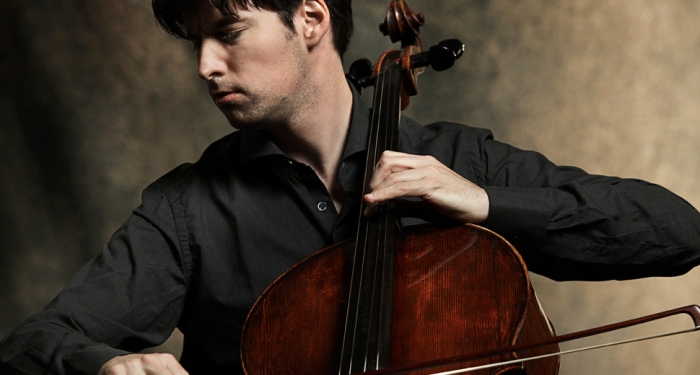Cellist Daniel Müller-Schott attacked the opening motif of Shostakovich’s Cello Concerto No 1 – a modified form of the composer’s musical signature ‘DSCH’ – with a full, elastic sound, giving the jagged four-note figure a lively bounce. Keeping the Sydney Symphony Orchestra on a tight rein, conductor Vladimir Ashkenazy – in the second of his Shostakovich tribute concerts with the SSO – kept the accompaniment textural and understated, allowing the cello to bask in the spotlight.
 Cellist Daniel Müller-Schott
Cellist Daniel Müller-Schott
The German cellist boasts fine credentials in this music – he studied with Mstislav Rostropovich, for whom Shostakovich wrote both of his cello concertos (the first in 1959 and the second in 1966), and Müller-Schott’s 2008 recording of the pair with the Symphonieorchester des Bayerischen Rundfunks was well received. While some players give the Allegretto a harder-edged quality, Müller-Schott brought out its lyricism in this performance – without losing the fierce energy that makes it such exciting music. He captured a mood of sonorous longing in the slow movement, his lonely cello melody underpinned by twisting violas and pizzicati from the lower strings. Ashkenazy allowed the accompaniment to unspool gradually without ever letting the tension slacken. The final passages, in which Müller-Schott’s dream-like harmonics were sprinkled with the icy glitter of celesta, were magical.
With a sound that was creamy in the upper register and languid in the low, Müller-Schott’s cadenza was spacious and brooding. His otherworldly pizzicati were resonant in the silent concert hall before the increasingly anxious cadenza was punctuated by orchestral accents and the music tumbled into the frenetic, bitterly comic finale, which saw the return of the DSCH motif. While a slightly spikier sound might have given the finale more forceful impact, Müller-Schott’s technique was impeccable and his liquid tone infused every note with depth and colour. Principal Horn Ben Jacks also deserves a mention, delivering a fine performance floating above the orchestra in counterpoint with Müller-Schott’s solos.
Shostakovich’s Eighth Symphony – the second in his trio of war symphonies, written in 1943 – didn’t garner the same level of approval from the authorities as his Fifth, which Ashkenazy and the SSO performed last week (read Limelight‘s review here). Lacking the bombastically affirmative ending of the latter, it was attacked by Andrei Zhdanov and the Central Committee of the Communist Party in 1948 and languished unperformed for many years. In 1956 Shostakovich lamented that his Eighth Symphony had been unperformed for so many years. “In this work there was an attempt to express the emotional experiences of the People, to reflect the terrible tragedy of war,” he wrote.
It is certainly a bleak work, opening with stark cellos and double basses before the cool sound of violins float over the top. While the Cello Concerto opens with a short, fragmentary motif, here Ashkenazy drew long lines from the orchestra, weaving threads of sound together to create a vast, severe musical landscape. If the crescendo isn’t as brutally obvious as the Bolero-like Nazis-marching-on-Leningrad section of Shostakovich’s Seventh, the moment when the lower strings added a more urgent accompaniment was charged and the entry of snare and brass triggered a frisson of excitement, the forward momentum inexorable before the music shattered into jagging strings, pizzicati and shrieking woodwinds. Monstrous rolling chords and thunderous brass stunned the audience before Alexandre Oguey delivered a warm, loving cor anglais solo over shivering strings.
The Allegretto’s march is almost cheerful, though undercut with a tightly wound energy. Rosamund Plummer’s skittering piccolo was a highlight, her sound glittering across the orchestra and reflected in the E flat clarinet.
The fierce violas of the third movement were soon punctuated by interjections from the basses, the hard impact of trombones and pizzicato strings jolting above motoring violins, Ashkenazy keeping it all taut throughout. The repeating bass line of the passacaglia fourth movement was haunting and tenebrous, coloured by flutter-tonguing flutes before Todd Gibson-Cornish’s bassoon announced the finale.
If the tension seemed to slacken in the final movement it was as much Shostakovich as Ashkenazy, the forward-momentum shed to highlight individual voices. The SSO’s playing was uniformly excellent and there were too many fine solos to mention them all – though Craig Wernicke’s agile bass clarinet and Shefali Pryor’s lyrical oboe deserve to be singled out. While the crashing thunder of the first movement returns in the last, Shostakovich’s Eighth ultimately ends gently and quietly – a reflective, heartfelt conclusion to the former SSO Chief’s tribute to the composer.
Vladimir Ashkenazy conducts the Sydney Symphony Orchestra in Gripping Shostakovich at the Sydney Opera House November 17 and 18.











Comments
Log in to join the conversation.